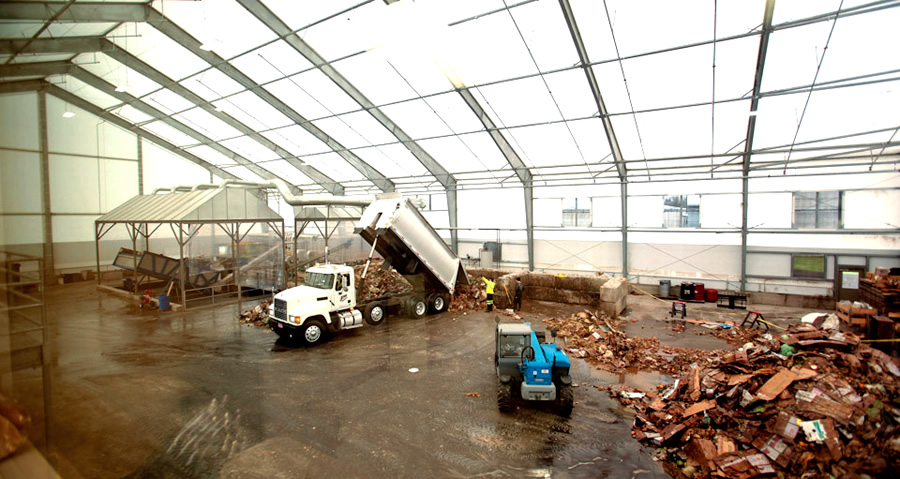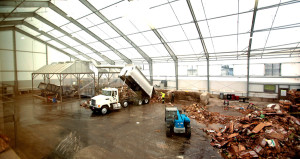Katrina Mendrey
BioCycle March/April 2014
Over the last eight years, Dean Foor, owner of Essential Consulting of Oregon, LLC, has consulted on projects across the U.S., including anaerobic digesters (AD) in South Carolina, Oregon and Florida. His latest project, JC-Biomethane, LLC in Junction City, Oregon, however, is Foor’s first venture into actually owning and operating an AD facility. JC-Biomethane is the only digester in the Pacific Northwest to operate almost entirely on postconsumer food waste. Less than five percent of the feedstock comes from manure, fats, oils and grease. No residential food scraps are received. “About 300 out of 360 tons/week, or about 80 percent, of the material we receive is postconsumer food waste from commercial sources in the Portland Metro area,” notes Foor.

The facility includes a homogenization tank, a continuously stirred tank reactor where feedstocks digest for 30 days and a post digester with a gas holder on top.
Proving that such a project was possible was the inspiration for going about it in the first place. As a consultant, Foor had observed many project ideas not come to fruition due to concerns about incentives and financing not coming together. “Basically we came to the conclusion that the best way to prove out the concept was to build a biogas plant on our own,” adds Foor.
The JC-Biomethane digester has been operational since mid 2013. Planning, permitting and financing took nearly three years to complete. Financing was pieced together from multiple sources. The $16 million project received $2 million from the Energy Trust of Oregon, $4.7 million in federal grants and a $1 million Oregon Business Energy Tax Credit. Additional capital was raised from a private equity firm, along with bank financing of about 15 percent of total project costs. Orchestrating the funding was essential to the project’s success according to Foor. “We were very fortunate to line up four different funding sources at the same time and if just one of those didn’t work out, the project would not have come to fruition,” he says.
Digester Operations
Actual construction took place over the course of 18 months beginning in late 2011. In full operation, the digester is capable of processing nearly 30,000 “as-is” (unprocessed) tons of organic residuals a year. Currently the plant receives approximately 60 to 80 tons a day, five days a week. It operates seven days a week to process incoming materials. This currently equates to about 20,000 tons/year.
Using a Swiss-made Hybag automation AG bioseparator, the incoming material is preprocessed to remove packaging contaminants. Foor estimates five to ten percent by mass of incoming loads contain cardboard, compostable bags and service ware that cannot go into the digester. Once these are removed by the bioseparator, the slurry is pumped into a 158,500-gallons homogenization tank where it remains for several days. From there, the material is pumped into the 1.2 million-gallons continuously stirred tank reactor (CSTR). Anaerobic bacteria digest the material for approximately 30 days before the digestate is passed into a 925,000 gallons post digester with a 4,000 cubic meter gas holder.
After the post digester, the coproducts — methane-rich biogas, fibrous solids and liquid nutrients — are separated. Solids pass through a FAN screw press to remove excess liquids, while the liquid is pumped into an additional tank capable of storing up to six months worth of liquid. Biogas is collected and piped into a tower to be cleaned by bacteria and remove excess water.
All three coproducts are then either reused onsite or nearby. The liquid residual is used to dilute incoming feedstocks as needed, moisten compost windrows during arid periods and applied as a liquid fertilizer at a nearby farm. Biogas fuels a 1.55 MW combined heat and power unit manufactured by MWM and packaged by 2G Cenergy. Heat produced from combustion is used to maintain the CSTR at 105°F. Blachly-Lane County Cooperative Electric Association and Bonneville Power Administration distribute electricity from the unit through established transmission lines for purchase by Portland General Electric (PGE) per a 20-year purchase power agreement (PPA).
Food Waste In, Soil Products Out
Fiber solids are sent to Lane Forest Products (LFP), a colocated but independent business producing and selling compost and other soil amendments. According to Oren Posner, Vice President of LFP, the solid material is surprisingly dry (50% solids), a testament to the efficiency of the screw press. The digester has yet to produce enough material to be incorporated into LFP’s full composting operation, however, Posner says LFP plans to compost it alone or with some manure and green waste in windrows.
LFP and JC-Biomethane also have partnered to transport materials between Junction City and Portland. Organic residuals originate from approximately 1,000 different generators in the Portland Metro area. They are collected and brought to a central transfer station in Portland, where Junction City-bound trucks transport the materials to JC-Biomethane. The trucks are then cleaned, filled with LFP products and sent back to Portland. About 35 tons are transported in each trip, notes Foor.
Once the residuals are delivered to JC-Biomethane, they are managed carefully to control odors. Located at the edge of the urban growth boundary, odor control at the facility is preemptive. Organic residuals are tipped and stored in a building that is continuously under negative pressure. Air is pulled into hoods where it flows through ductwork and into a 60-foot chamber containing UV lights and ozone to neutralize volatile organic compounds (VOCs). It is the first biogas plant to use ozone as an odor control measure in the United States, according to Foor. The facility has not received an odor complaint to date.
The project itself has been a balance of lessons learned, sheer luck and a lot of hard work, he adds. “There are challenges we are working through. But… by and large, we are doing exactly what we set out to do, which is recover nutrients and energy from food waste and get them back into the community in the form of agricultural supplements and renewable energy.”
Katrina Mendrey, a BioCycle Contributing Editor, recently completed a Master’s degree in Soil Science from the University of Washington.














